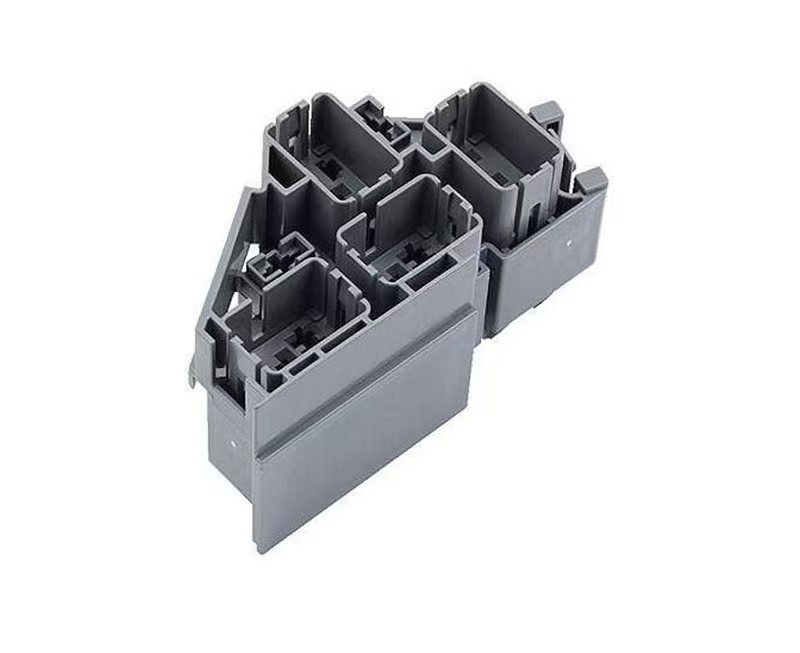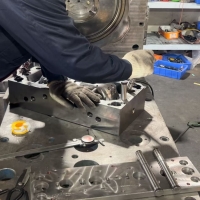Las causas y soluciones de burbujas, pegajos de moho y compuerta en productos moldeados por inyección
Las causas y soluciones de burbujas, el moho pegado y la puerta se adhiereninyección moldeadaproductos
Molde Co.,Ltd. de Taizhou Jiefeng del coche (jfmoulds.com)
Defecto del producto | Razones posibles | Solución |
Burbujas en el producto | 1. El plástico está húmedo, que contiene humedad, solventes o sustancias volátiles. 2. Las partículas del material son demasiado finas, desiguales o tienen una presión posterior baja, la temperatura en el extremo trasero del barril es alto o el aire se mezcla en el extremo de alimentación o el material se flota y gira. 3. Insuficiente relleno en la cavidad del moho o puertas y canales de corredores demasiado pequeños. 4. La configuración de presión y velocidad de inyección son demasiado bajas. 5. El tiempo de inyección es demasiado bajo. 6. La temperatura del molde es baja o desigual, y la temperatura de la boquilla es demasiado alta. | 1. Antes de moldeo por inyección, el compuesto de goma debe secarse primero, y también es necesario evitar grandes cambios de temperatura durante el procesamiento. 2. Para partículas finas o materiales desiguales, establezca la temperatura al final de cada zona del barril para evitar que el aire ingrese durante el moldeo por inyección. 3. Expanda las dimensiones de la puerta y el corredor, y verifique el puerto de descarga o los parámetros de acción de inyección. 4. Aumente los valores establecidos de presión y velocidad de inyección. 5. Aumente el valor de ajuste del parámetro de tiempo de inyección. 6. Inspeccione el sistema de enfriamiento del molde, reorganíquelo para garantizar que la temperatura del molde de trabajo sea consistente y reduzca el valor de temperatura establecido de la boquilla. |
| Producto que se adhiere al molde | 1. El tamaño de la puerta es demasiado grande o el ángulo de borrador de la cavidad es demasiado pequeño. 2. La estructura de la demolda no es razonable o hay una posición invertida dentro del dado. 3. La pared interna de la herramienta y la muerte no es lo suficientemente suave o tiene abolladuras y rasguños. 4. La temperatura es demasiado alta o la presión de inyección es demasiado grande. 5. El parámetro de tiempo de inyección se establece demasiado tiempo. 6. El parámetro de tiempo de enfriamiento se establece demasiado corto. 7. La superficie del producto en el molde no se ha enfriado y endurecido o la temperatura del molde es demasiado alta. 8. La temperatura de la boquilla es baja, y el arco de la boquilla no coincide con el de la manga de la puerta o. 9. Hay impurezas en el diámetro del orificio de la boquilla o el diámetro del orificio de la manga de la puerta es más pequeño que el diámetro del orificio de la boquilla debido al mal ajuste. | 1.Modify the design dimensions of the mold gate and cavity. 2. The mold structure should be reasonable. Remove the inverted part, grind and polish it, and increase the slope of the demolding part. 3. Polish the inner wall of the model cavity again. After grinding and treating the dents and scratches, polish it again. 4. Reduce the material temperature, decrease the injection pressure, and lower the screw speed or back pressure. 5. Reduce the set value of the injection time parameter. 6. Increase the setting value of the cooling time parameter. 7. Extend the holding pressure time and enhance the cooling of the working die to reduce the die temperature. 8. Reduce the temperature of the nozzle, adjust or repair it to make the nozzle fit the gate sleeve. 9. Remove impurities from the nozzle hole and the gate sleeve, and replace the nozzle hole diameter or modify the gate sleeve hole diameter. |
| The gate is stuck to the mold | 1.The gate dimension is insufficient or no release agent is used. 2. The gate is too large or the cooling time is too short. 3. High material temperature, short cooling time, and poor shrinkage. 4. There are damages or dents on the surface of the tool and die. 5. Excessive injection pressure causes the product not to fully protrude when demolded, or the remaining part breaks the broken glue inside the mold. 6. Excessive injection pressure causes the holes in complex cavities to be blocked, forming glue columns and leading to needle breakage. | 1.Increase the degree of drowsiness by using an appropriate amount of detilli. 2. Extend the cooling time and reduce the gate diameter. 3. Reduce the material temperature and increase the cooling time to ensure good shrinkage. 4. Repair the model cavity and polish the surface. 5. Adjust the process technical parameters, such as reducing the pressure of the paper injection stock and the action parameters of the ejector pin, to prevent adhesive breakage. 6. Adjust the process parameters. Reduce the injection pressure or progress to prevent needle breakage. |
| Flash on the product | 1.The temperature of the plastic and the die is too high. 2. The injection pressure is too high or the plastic has excessive fluidity. 3. Asymmetry on both sides of the die or uneven clamping force. 4. Imbalance of the template or deformation of the guide pins leads to poor parallelism of the mold. 5. El tiempo de inyección se establece demasiado tiempo. 6. There are obstructions on the die edge, causing poor sealing of the parting surface, or partial sliding of the cavity and core, and the original size between parts is too large. | 1.Reduce the temperature of the plastic heating cylinder and the working die. 2. Reduce the injection pressure or speed. 3. Adjust the symmetry of the working die and the mold, and adjust the clamping force parameters. 4. Adjust and balance the mold and template to ensure even force distribution on all four sides. 5. Reduce the setting of the shooting and receiving time parameter. 6. Clean and polish the edges. Repair or replace parts that are too large. |
Molde Co.,Ltd. de Taizhou Jiefeng de Mould_Taizhou de la materia (jfmoulds.com)

Información relacionada
Moldes de inyección: el "gen industrial" escondido detrás de todo
2025-07-12
Moldes de inyección: el "gen industrial" escondido detrás de todo cuando nuestro fing...
Moldes de inyección: la base de precisión y el motor de innovación de la fabricación industrial
2025-07-02
Moldes de inyección: la base de precisión y el motor de innovación de...
Tecnología de puerta de moho de inyección
2025-07-23
Inyection Mold Gate Technologygating Systemauto Mould_taizhou Jiefeng Mold Co., ...
Proceso de procesamiento de diseño de fabricación de moldes
2025-06-19
El flujo del proceso de 1. fabricación de moldes es el siguiente: revisión de dibujo-material...
Molde de inyección comúnmente utilizado seis tipos de materiales de molde
2025-06-19
La elección del acero no solo afecta la vida útil del molde, sino...
Exploración de moldes de inyección: un análisis integral desde el diseño hasta la aplicación
2025-07-08
Explorando moldes de inyección: un análisis exhaustivo desde el diseño hasta la aplicación...





